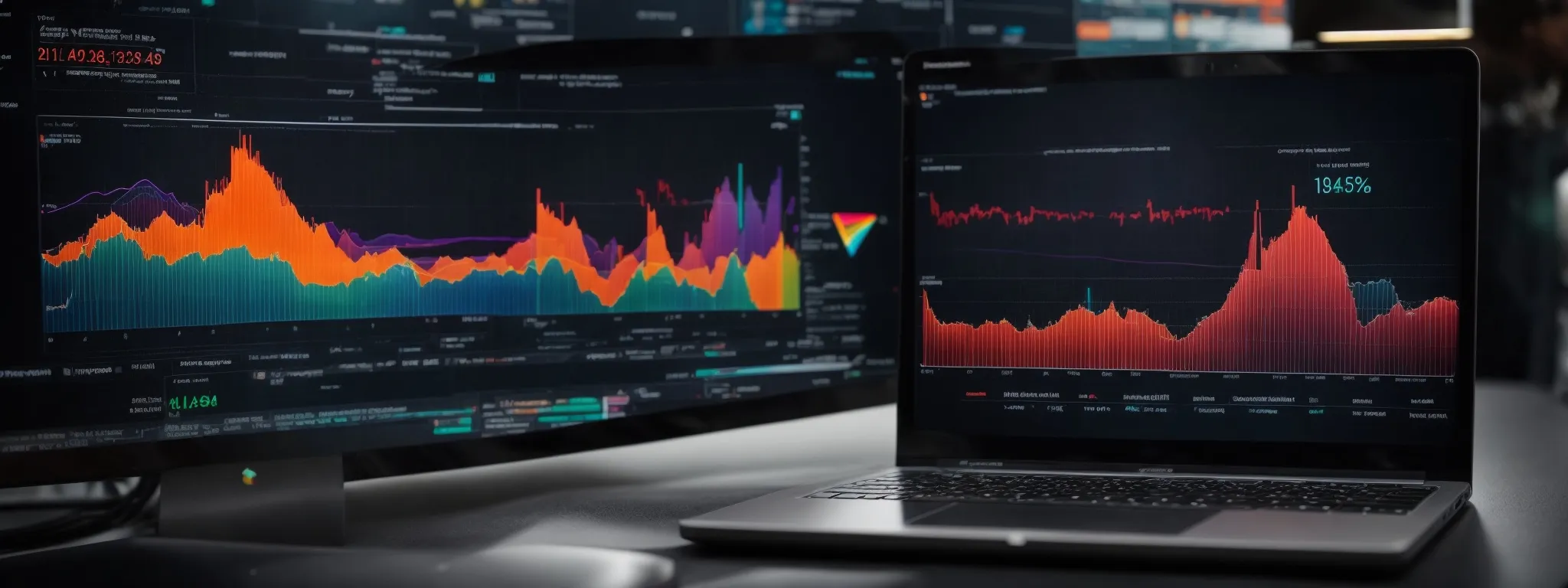How to Optimize E-Commerce Website
Maximizing Your Online Store’s Potential: The Guide to E-Commerce Website Optimization In the competitive world of digital retail, optimizing your ecommerce website is not just an advantage, […]
Maximizing Your Online Store’s Potential: The Guide to E-Commerce Website Optimization
In the competitive world of digital retail, optimizing your ecommerce website is not just an advantage, it’s a necessity.
With the right strategies, including enhancing product pages and mastering search engine optimization (SEO), businesses can significantly increase their conversion rates and overall order value.
LinkGraph’s comprehensive SEO services, coupled with the powerful Search Atlas SEO tool, stand as pillars for any ecommerce business aiming to fine-tune their online presence.
A meticulously optimized ecommerce site serves as a magnet for target audiences, guiding them from initial search terms to the checkout page with ease and efficiency.
Keep reading to discover how to transform your online store into a powerhouse of shopper satisfaction and revenue generation.
Key Takeaways
- LinkGraph’s SEO Services Utilize Strategic Keyword Research, High-Quality Images, and User-Generated Content to Enhance E-Commerce Site Visibility
- Clear and Strategic Call-to-Actions (CTAs), Secure Checkout Processes, and Mobile Optimization Are Crucial for Improving Conversion Rates on E-Commerce Platforms
- E-Commerce Sites Benefit From Segmenting Audience and Leveraging Data Analytics to Personalize the Shopping Experience and Marketing Efforts
- Regular Updates and SSL Certificates Are Essential for Maintaining the Security and Trust of an E-Commerce Website
- A/B Testing and Continuous Optimization Across an E-Commerce Site Can Significantly Boost User Engagement and Conversion Rates
Enhancing Product Pages for Maximum Conversion

In the dynamic world of e-commerce, every pixel and word on your website wields the power to influence consumer behavior.
Within this intricate digital tapestry, product pages stand out as pivotal touchpoints that can propel a browser towards becoming a buyer.
A clear focus on optimizing product descriptions with targeted SEO keywords can significantly improve visibility and traction.
On par with compelling copy, the deployment of high-quality images and videos serves to enthrall and convince visitors of the value proposition.
To amplify this effect, LinkGraph’s innovative SEO services adeptly display the persuasive strength of customer reviews and ratings, harnessing social proof to elevate trust and interest.
Coupled with strategic and unmistakable call-to-actions, LinkGraph ensures the pathway to purchase is persuasive and uncluttered.
Moreover, the design and placement of the checkout button are meticulously refined to streamline the purchasing process, assuring a smooth transition from interest to conversion.
Optimize Product Descriptions With SEO Keywords
The subtle art of infusing SEO into product descriptions should never be underestimated in an ecommerce business’s toolkit. Using LinkGraph’s Search Atlas SEO tool, companies can identify the most impactful search terms, integrating them into product titles, features, and descriptions to ensure each product page resonates with the searcher’s intent and climbs the SERPs effectively.
LinkGraph’s meticulous keyword research grounds the e-commerce experience in data-driven strategy, turning each product page into a beacon for target audiences. By optimizing these descriptions, ecommerce sites nonchalantly guide search engines and potential customers towards a match, enhancing visibility and solidifying the relevance of the shopper’s journey.
Use High-Quality Images and Videos
High-resolution product images and engaging videos serve as the visual handshake between the ecommerce site and its customers, playing a pivotal role in the shopping experience. By utilizing WebP format for superior site speed and reduced load times, LinkGraph ensures that product showcases are not only vibrant but also efficient, catering to the fast-paced demands of modern consumers.
Embedding multimedia content like 360-degree views and product demonstration videos, LinkGraph crafts a narrative around each item, thus enabling clients to visualize the products in context. This immersive approach can nudge the visitor along the path to purchase by simulating an in-store experience, fostering confidence and minimizing the hesitation that often leads to abandoned carts.
Showcase Customer Reviews and Ratings
Integrating customer reviews and ratings on product pages is a strategic move that leverages user-generated content to build credibility. LinkGraph’s SEO services capitalize on this by fostering a platform where shoppers can share their experiences, effectively using social validation to impact the purchasing decisions of new customers.
This transparency not only aids in building consumer trust but also enhances the content on the ecommerce site, feeding into the SEO ecosystem. User-generated reviews often contain long-tail keywords and specific search terms relevant to potential customers, further optimizing product pages for search engines:
| Feature | Benefit | Impact on SEO |
|---|---|---|
| Customer Reviews | Builds trust and provides social proof | Enhances long-tail keyword density |
| Star Ratings | Offers a quick visual cue on product quality | Improves click-through rates from SERP |
| Review Filters | Helps shoppers find the most relevant testimonials | Increases time on page and user engagement |
Employ Persuasive and Clear Call-to-Actions
Call-to-actions (CTAs) are the linchpins in the conversion journey that propel a visitor from mere interest to affirmative action. Precise, action-oriented language crafted by LinkGraph ensures that every CTA button is a clarion call that resonates with the shopper’s intent to purchase or learn more about a product.
Understanding the impact of CTAs on conversion rates, LinkGraph emphasizes their strategic placement and design across ecommerce sites to minimize friction and maximize customer engagement. An optimized checkout process, clear incentives for immediate purchase, such as flash sale announcements, and assurances of secure transactions comprise a trio of tactics designed to boost conversions:
- Optimized Checkout Process: Simplifies the final step in the purchasing funnel, increasing the likelihood of completion.
- Flash Sale Announcements: Creates a sense of urgency, encouraging on-the-spot decision-making.
- Secure Transaction Assurances: Instills confidence during the checkout, reducing cart abandonment.
Streamline the Checkout Button Design and Placement
LinkGraph places considerable emphasis on the impact of design in a successful ecommerce optimization strategy. Recognizing that even a well-placed, aesthetically refined checkout button can shave seconds off the decision-making process, they ensure its visibility and accessibility on the product page are optimized for enhanced user experience and increased conversion rates.
The preciseness of the checkout button’s placement can act as a silent guide, leading the user towards completing their purchase with confidence and ease. LinkGraph’s approach considers the symmetry of design and behavioral patterns, taking into account varying devices and ensuring the checkout journey is as seamless on a mobile screen as it is on a desktop.
Mastering SEO for E-Commerce Success

The digital marketplace thrives on visibility, and at the heart of this visibility lies a robust search engine optimization strategy.
For any e-commerce business eager to flourish, mastering the nuances of SEO is non-negotiable.
It begins with deep dives into keyword research tailored to a store’s unique niche, laying the foundational bedrock for organic discovery.
From there, the construction of a crisp, logical site hierarchy ensures that visitors and search engines can navigate with ease, bolstering the overall user experience.
As shoppers peruse selections, SEO-friendly product categories, optimized meta tags, and meticulously crafted product titles beckon the search engine’s favor.
Moreover, the art of weaving an internal linking web entices customers to explore further while simultaneously fortifying the site’s SEO narrative—a narrative that LinkGraph’s services sculpt with precision and forward-thinking technique.
Conduct Thorough Keyword Research for Your Niche
At the core of any effective e-commerce strategy lies the power of keyword research, an area where LinkGraph’s Search Atlas SEO tool truly excels. By capturing the lexicon of the target consumer, LinkGraph equips e-commerce businesses with the insight needed to curate content that aligns with their audience’s search behavior and interests.
A refined keyword strategy transcends basic optimization; it influences the user journey from initial touchpoint to the final click. LinkGraph’s detailed analysis reports pinpoint precise search terms, empowering developers and content creators to shape an e-commerce site that speaks directly to the needs and desires of their audience:
- Identification of high-value search terms relevant to the niche market.
- Analysis of keyword performance and search volume to prioritize content creation.
- Insights into audience search behavior for strategic content and website structuring.
Structure Your Site With a Clear Hierarchy
LinkGraph’s strategic prowess shines in orchestrating a site hierarchy that is not only intuitive but SEO-effective. The company’s approach ensures that customers can navigate an e-commerce website with unhindered clarity, promoting a frictionless shopping experience that search engines acknowledge with higher rankings.
Engaging in this hierarchical optimization, LinkGraph crafts a sitemap that guides both the user and search engine crawlers through the e-commerce journey—from landing page to product page, through breadcrumbs and category divisions, with elegance and strategic intent. This structural clarity aligns with the shopper’s expectations, supporting an efficient pathway to conversion and bolstering the ecommerce store’s online presence.
Create SEO-friendly Product Categories
Crucial to optimising an e-commerce website, SEO-friendly product categories act as pivotal signposts that guide shoppers towards their desired items. LinkGraph excels in meticulously structuring these categories to reflect popular search queries, ensuring that each category aligns with the consumer’s search intent and enhances the discoverability of products.
Their approach to organization transcends mere taxonomy, as the design of product categories is tailored to produce clear, intuitive user pathways. This facet of optimization not only improves the shopper’s site navigation but also fortifies the website’s structure, making it more attractive and understandable to search engine algorithms, a testament to LinkGraph’s dedication to comprehensive e-commerce optimization.
Optimize Meta Tags and Product Titles
Product titles and meta tags form the cornerstone of on-page SEO, serving as the introductory handshake between your ecommerce product and the discerning eye of the search engine. LinkGraph optimizes these critical elements with precision, ensuring they are not only attention-grabbing but also rich with the target keywords that echo the search intent of the prospective customer.
With the prowess of LinkGraph’s SEO strategies, ecommerce businesses witness their product pages climbing the rankings, as tailor-made meta descriptions offer compelling summaries that entice the searcher to click through. This meticulous crafting of meta tags and product titles magnifies the product’s digital storefront, positioning the ecommerce brand prominently at the forefront of the search engine results page.
Implement a Strategic Internal Linking Practice
Internal linking stands as a robust pillar in LinkGraph’s strategic arsenal, grounding the ecommerce site’s architecture in smart connectivity. By skillfully interlinking product pages, articles, and category pages, they lay out a navigation-friendly map for users, subtly increasing the time spent on site and encouraging a deeper engagement with the brand’s offerings.
With a keen understanding of the consumer’s journey, LinkGraph ensures internal links are not only contextually relevant but also strategically placed to distribute page authority throughout the site. This internal linking system reinforces the ecommerce store’s SEO framework, allowing search engines to crawl and index pages more effectively, thus amplifying the site’s overall search engine presence.
Leveraging Analytics for E-Commerce Insights

Unlocking the full potential of an e-commerce website demands a keen understanding of the treasure trove of data it generates.
This is where analytics enters the fray, offering invaluable insights that anchor strategic improvements.
By setting up a robust analytics tracking system, LinkGraph aids clients in capturing intricate details of customer behavior, illuminating patterns that indicate where and why potential buyers drift away.
Further, careful scrutiny of traffic sources sharpens marketing endeavors, allowing for the refinement of outreach efforts.
Employing a data-driven approach extends to product pricing strategies as well, thereby ensuring each decision is underscored by empirical evidence rather than conjecture.
LinkGraph positions its clientele to harness the full power of analytics, transforming raw data into a compass that guides every facet of e-commerce optimization.
Set Up E-Commerce Tracking With Your Analytics Platform
To fully harness the insights available from online customer interactions, establishing precise e-commerce tracking with a reliable analytics platform is essential. LinkGraph assists its clients in configuring e-commerce tracking systems that meticulously capture data points across every stage of the consumer journey, providing clarity on which elements of their site are driving performance.
With the implementation of robust e-commerce analytics, businesses acquire the capability to monitor in real-time the effectiveness of their website, adjusting strategies accordingly to optimize conversion rates. The data gleaned from these analytics enables the presence of measurable benchmarks, thus empowering LinkGraph’s clients to make informed decisions that can significantly impact their bottom line:
| Data Point | Utility | Impact on Decision-Making |
|---|---|---|
| Conversion Rate | Measures the success of CTAs and overall website effectiveness | Provides insight into the efficacy of user experience design and prompts necessary adjustments |
| Average Order Value | Gauges the revenue generated per transaction | Aids in the assessment of product pricing and promotional strategies |
| Bounce Rate | Indicates user engagement and content relevancy | Highlights areas for improvement in content strategy and site architecture |
Analyze Customer Behavior to Identify Drop-Off Points
Analyzing customer behavior offers ecommerce businesses a window into the complex journey of their audience. LinkGraph’s SEO services arm ecommerce sites with the tools to dissect visitor interactions, revealing critical drop-off points where potential customers disengage. By shining a light on these areas, retailers are afforded the opportunity to refine their shopping experience, ensuring that every step from product discovery to the checkout page is streamlined and user-friendly.
Through meticulous observation of user paths and engagement, LinkGraph identifies patterns that highlight obstacles within the ecommerce funnel. Tactical adjustments based on this analysis can lead to significant enhancements in user experience, which in turn can bolster conversion rates and reduce abandonment. This level of insight empowers online stores to craft a consumer journey that aligns with expectations and encourages completion of the purchase process.
Monitor Traffic Sources to Optimize Marketing Strategies
LinkGraph equips e-commerce sites with the insight to distill their marketing strategies through diligent monitoring of traffic sources. By discerning which channels yield the highest engagement and conversion, businesses can allocate resources judiciously, enhancing the efficiency of their marketing investments.
Differentiating between organic search, paid campaigns, social media referrals, and direct traffic, LinkGraph’s expertise assists clients in tailoring their outreach to the channels most favored by their target audience. This strategic recalibration, hinged on traffic source analysis, ensures marketing efforts resonate more profoundly with potential customers, driving amplified returns for the ecommerce business.
Use Analytics to Refine Your Product Pricing Strategy
Analytical data stands as a beacon, guiding e-commerce entities through the murky waters of product pricing. LinkGraph augments this approach by mining data from the analytics, distilling actionable insights that can inform dynamic pricing strategies, nudging online store owners to pivot or hold steady, anchored in empirical evidence rather than mere conjecture.
The use of analytics in determining the sweet spot for product pricing does more than inform; it translates consumer behavior into profitable adjustments. Recognizing this, LinkGraph facilitates a rigorous analytical review, empowering clients to optimize pricing in response to the purchasing patterns, elasticity of demand, and competitive landscape, fostering an environment primed for revenue growth and customer satisfaction.
Crafting a Seamless Mobile Shopping Experience

In today’s digital-first economy, a seamless mobile shopping experience is non-negotiable for e-commerce success.
Consumers increasingly depend on their mobile devices for shopping, making it imperative for online stores to optimize their mobile interface.
An emphasis on responsive web design ensures optimal display across all devices, while meticulous optimization of image sizes and layout advances site speed, vital for retaining the mobile user’s limited attention span.
Further, the nuances of touchscreen navigation require thoughtful design to facilitate a swift and satisfying browsing experience.
Above all, guaranteeing that the mobile checkout process is streamlined and user-friendly can be the defining factor between an abandoned cart and a completed transaction.
These touchstones form the bedrock of a mobile experience that not only meets but exceeds the expectations of the contemporary shopper.
Implement a Responsive Web Design
Responsive web design stands as a fundamental component in LinkGraph’s toolkit for optimizing an e-commerce platform. By adopting a fluid grid layout that adjusts to the screen size and orientation of any device, LinkGraph ensures that visitors have a consistent and tailored shopping experience across all platforms.
This level of adaptability is not only user-centric but also favorable from an SEO standpoint: search engines favor websites that cater to the mobile user. Recognizing this, LinkGraph elegantly crafts responsive sites that retain functionality and aesthetics, regardless of the user’s chosen device:
- Fluid grids enable content to resize and adapt to different screen resolutions without sacrificing readability or functionality.
- Responsive images and media queries ensure visual content remains compelling on small screens, contributing to faster page loads and improved user experience.
- Touch-friendly navigation elements are optimized to respond to mobile users’ actions, making interaction intuitive and satisfying.
Executing such a responsive design paradigm systematically elevates the user experience, keeping shoppers engaged and reducing bounce rates. LinkGraph harnesses state-of-the-art web technologies to deliver responsive designs that adeptly bridge the gap between various devices, ensuring each user interaction is as optimized and conversion-focused as if it were on the desktop.
Optimize Image Sizes and Layout for Speed
In the quest to keep pace with the fast scrolls and swift taps characteristic of the mobile user, optimizing image sizes and layout is paramount. LinkGraph champions strategies that reduce image file sizes without compromising on quality, ensuring swift page loads that cater to the rapid browsing habits of the mobile audience.
- Strategic compression techniques that minimize file sizes while preserving visual clarity
- Responsive image solutions that deliver different image sizes based on the device’s requirements
- Layout redesigns that prevent unnecessary image loading, further accelerating site performance
This meticulous tuning of visual elements aligns perfectly with mobile users’ expectations for instantaneity, lowering bounce rates and fostering longer, more engaging sessions. Ultimately, such optimizations contribute to a swifter mobile experience, propelling an ecommerce website closer to its performance zenith.
Ensure Easy Navigation on Touchscreen Devices
Navigational ease on touchscreen devices is not just a comfort—it’s essential for retaining the mobile shopper’s attention. LinkGraph’s approach ensures that the touch targets on e-commerce sites are sized and spaced to facilitate easy tapping, with an interface that caters to the nuances of finger-based navigation.
The strategic placement of navigational elements by LinkGraph prevents the common pitfall of overcrowding on small screens, which can lead to user frustration and increased bounce rates. Their design philosophy prioritizes a clear path for the user, establishing a touchscreen-friendly environment that enhances the shopper’s journey and supports conversion optimization.
Test the Mobile Checkout Process for Ease of Use
Testing the mobile checkout process is pivotal in guaranteeing a frictionless transaction for customers. LinkGraph’s method of assessment involves a thorough scrutiny of the mobile checkout process to identify and eradicate any potential hindrances that may impede a shopper’s progression to a sale.
- Analysis of form length and field requirements to ensure they are concise and non-repetitive.
- Examination of payment gateway integrations to provide a wide range of secure options.
- Verification that confirmation pages load quickly and display clearly on mobile devices.
By simulating real-world conditions, LinkGraph’s testing uncovers the subtleties that can make or break the mobile checkout experience: from the typing ease on small touchscreen keyboards to the loading time of the final confirmation page.
Utilizing Social Proof to Build Customer Trust

In the intricate realm of e-commerce, the power of social proof stands as a cornerstone of consumer trust and brand credibility.
As shoppers navigate the vast sea of online stores, those that effectively showcase social validation through user-generated content, customer testimonials, and endorsements not only capture attention but deepen the connections with their audience.
This section delves into the strategic integration of these elements to bolster customer confidence and convert users into advocates, reinforcing the indispensability of social proof in optimizing an e-commerce website.
Display User-Generated Content and Reviews Prominently
LinkGraph understands the compelling nature of user-generated content and its ability to instill trust among prospective buyers. They ensure that customer reviews and user testimonials take center stage on e-commerce product pages, enabling new visitors to gauge the authenticity and quality of the brand’s offerings through the experiences of others.
Incorporating user feedback into the fabric of the ecommerce site, LinkGraph’s strategies involve placing user-generated content where it can have the most impact—in clear view. This makes it one of the first elements a potential customer encounters, thereby enhancing the credibility of the product and the overall brand.
Feature Customer Testimonials and Case Studies
LinkGraph deftly integrates customer testimonials and case studies into e-commerce platforms, offering tangible embodiments of the brand’s efficacy. These powerful narratives not only highlight customer satisfaction but also elucidate the practical application and results of products, contributing to a trustworthy reputation.
Through real-world examples depicted in case studies, LinkGraph effectively communicates the transformative potential of products, thereby facilitating informed purchasing decisions. This strategic showcasing underscores the value proposition of the ecommerce business, fostering a deeper level of trust between the company and its consumers.
Highlight Social Shares and Endorsements
In the landscape of e-commerce optimization, social shares and endorsements carry significant weight in establishing a brand’s social footprint. LinkGraph accentuates this facet by curating and highlighting these markers of external validation, which serve as powerful indicators of a brand’s popularity and trustworthiness.
Endorsements from influencers and satisfied customers, when prominently displayed, act as compelling testimonials to the quality and desirability of the e-commerce store’s offerings. Such endorsements, strategically presented on various platforms, can decisively influence consumer perceptions and decision-making processes:
- Strategically positioned social share buttons to encourage consumers to spread the word about their positive experiences.
- Utilization of influencer partnerships to expand brand reach and leverage credibility within niche markets.
- Integration of real-time social feed displays showcasing current trends and customer engagement.
Cutting Down Loading Times for Better UX

In an ecosystem where user retention is contingent on swift and responsive interactions, e-commerce websites must prioritize optimization of their loading times to provide an unparalleled user experience (UX).
A strategic focus on this aspect not only fortifies user engagement but also bolsters search engine rankings—a dual advantage that cannot be understated.
This section highlights imperative techniques that will help e-commerce businesses assess their current speed metrics, streamline resource delivery, harness the power of browser caching, and compress visual assets to ensure their online storefronts operate at peak efficiency.
Embracing these best practices will equip e-commerce platforms to enhance UX and retain the ever-ephemeral attention of the modern digital shopper.
Evaluate Current Load Times With Speed Testing Tools
A firm understanding of an e-commerce website’s baseline performance begins with a thorough assessment of load times. Harnessing the capabilities of speed testing tools, LinkGraph expertly analyzes current site speeds, uncovering critical insights into performance benchmarks and identifying opportunities for optimization.
- Utilization of industry-leading tools to provide an accurate reading of page load times.
- Detailed reporting that isolates bottlenecks affecting user experience.
- Insights gathered act as a blueprint for targeted improvement strategies.
Armed with data from these precise diagnostic tools, LinkGraph’s SEO professionals tailor custom solutions to expedite load times. By streamlining the delivery of web resources, they enhance the site’s responsiveness, thus elevating user satisfaction and solidifying search engine rankings.
Minimize HTTP Requests and Optimize Files
LinkGraph leads the charge in trimming the fat from e-commerce platforms by reducing the volume of HTTP requests. Their teams optimize files for streamlined delivery, ensuring that each request contributes directly to an element crucial to the user’s experience, thereby reducing the latency that can frustrate a visitor and precipitate their exit from the site.
In this pursuit of efficiency, LinkGraph rigorously refactors code and combines files where possible, creating an environment where stylesheets and scripts are consolidated. This consolidation curtails extraneous HTTP requests and fosters a more rapid content rendering process, translating to blisteringly fast page loads that keep the user’s attention locked on the ecommerce site.
Leverage Browser Caching to Speed Up Repeat Visits
Leveraging browser caching is a strategic move that streamlines the shopping experience for returning visitors to an e-commerce site. By storing aspects of the site locally in the user’s browser, LinkGraph ensures that subsequent visits benefit from significantly faster load times.
This optimization tactic, essential for enhancing user experience, keeps consumers engaged and reduces the likelihood of site abandonment due to slow performance. As users revisit an e-commerce platform optimized by LinkGraph, they encounter a swift, responsive interface that remembers their previous interactions:
- Assets like images and stylesheets load promptly, recalling the user’s last encounter with the site.
- Critical business elements, such as product catalogues and checkout forms, reappear without delay, fostering brand continuity and ease of use.
- Navigational structures and interactive features benefit from cached information, delivering a consistent and efficient browsing journey.
Compress Images Without Losing Quality
LinkGraph champions a custom approach to image compression that maintains the aesthetic appeal while striking a balance with load times.
Their expertise ensures that visuals on an e-commerce site are optimized to their smallest file size, thus accelerating page rendering without compromising the sharp, clear quality customers expect.
Optimizing Checkout for Reduced Cart Abandonment

Charting the path to a purchase should be as direct and obstacle-free as possible, a principle that underpins the importance of checkout optimization in e-commerce scenarios.
An optimized checkout process is pivotal to curbing shopping cart abandonment, a common challenge for online retailers aiming to maximize conversions.
From streamlining the entire process to a few steps, offering a diverse array of payment options, providing transparent delivery details with cost breakdowns, to enabling guest checkout options, these strategies are key in refining the path to purchase.
LinkGraph’s proven methodologies ensure a seamless checkout experience, laying a smooth runway for shoppers to effortlessly conclude their transactions.
Simplify the Checkout Process to a Few Steps
Streamlining the checkout process is an imperative strategy to diminish cart abandonment rates on e-commerce sites. By condensing the process into a few clear steps, LinkGraph helps its clients eliminate customer frustration and ease the transition from selection to purchase.
Efficiency at this stage is paramount: a concise checkout form with autofill options for returning customers can significantly expedite the transaction. LinkGraph’s expertise in simplifying the checkout experience pays dividends in customer retention and conversion rate uplift:
- Implement autofill capabilities to minimize user input and accelerate the checkout process.
- Reduce the number of checkout steps to maintain customer momentum towards purchase completion.
- Streamline form fields to request only essential information, avoiding needless complexity.
Offer a Variety of Payment Options to Suit User Preferences
Acknowledging the diversity of consumer payment preferences, LinkGraph strategically advises e-commerce businesses to incorporate a broad spectrum of payment methods. This inclusive approach not only caters to the varied financial ecosystems but also subtly encourages the shopper to proceed with the transaction, knowing their preferred mode of payment is readily available.
LinkGraph’s nuanced understanding of payment gateway integration directly addresses a vital component of the checkout experience. Their recommendations encompass traditional credit and debit options as well as emerging digital wallets and localized payment systems, ensuring an ecommerce store presents itself as an accessible and customer-friendly marketplace.
Provide Clear Delivery Information and Costs Upfront
Transparency in delivery terms sets the stage for a positive customer experience, which LinkGraph’s strategies prioritize at the ecommerce checkout. By diligently presenting delivery information, inclusive of all costs and expected delivery times, up front, LinkGraph champion stores instill a sense of reliability and trust in their customers.
Understanding that unexpected costs are a predominant factor in cart abandonment, LinkGraph’s approach ensures customers encounter no surprises during the checkout process. This clarity not only aligns with consumer expectations but also aligns perfectly with ecommerce best practices, reaffirming their commitment to user-centricity:
| Checkout Element | Importance | LinkGraph’s Implementation Strategy |
|---|---|---|
| Delivery Information | Crucial for setting customer delivery expectations | Clearly outlined expected delivery times and processes |
| Cost Transparency | Prevents last-minute customer drop-off due to unexpected fees | All costs, including shipping and handling, disclosed early in the checkout |
| Trustworthiness | Enhances the customer’s perception of the brand | Delivery terms and costs are communicated in a clear, concise manner |
Implement a Guest Checkout Option to Facilitate Purchases
To streamline the path to purchase, LinkGraph advocates for the inclusion of a guest checkout option within e-commerce platforms. This feature addresses the preferences of consumers who wish to avoid the additional step of creating an account, thus reducing friction and encouraging on-the-spot transactions.
Embracing this functionality, LinkGraph’s approach spotlights the importance of convenience and speed in the checkout experience, reinforcing the necessity to accommodate those seeking a swift purchase without the strings of registration:
- Facilitate a faster checkout experience by bypassing the account creation requirement.
- Mitigate potential resistance by offering a direct route to purchase for all users.
Tailoring User Experience With Personalization

Within the digital expanse of e-commerce, a personalized user experience stands as a prime catalyst for success.
As online shopping becomes increasingly prevalent, the quest to provide a singularly tailored journey for every visitor has transitioned from a luxury to an essential component of e-commerce website optimization.
Employing intelligent recommendation engines, custom-tailored offers and promotions, and segmented email marketing techniques, businesses can cultivate a sense of individual attention that resonates deeply with consumers.
This customization not only fosters a strong customer connection but also encourages loyalty, thereby fortifying an online store’s competitive edge.
Deploy Recommendation Engines Tailored to User Behavior
Understanding the nuances of individual shopper preferences, LinkGraph harnesses the power of recommendation engines to heighten the user experience on e-commerce platforms. The integration of these engines aligns current browsing behaviors and historical purchase data to predict and suggest items of likely interest, creating a tailored shopping journey for each user.
LinkGraph’s deployment of sophisticated algorithms ensures that recommendation engines serve up the most relevant products, engaging the consumer with personalized options that resonate with their specific tastes and buying patterns. This approach significantly augments user engagement, fostering increased time on site and elevating the likelihood of repeat visits and conversions.
Personalize Offers and Promotions Based on Past Purchases
LinkGraph’s sophisticated approach to e-commerce optimization includes the personalization of offers and promotions based on an individual’s purchase history. This strategy nurtures a sense of exclusivity and recognition, encouraging repeat business by appealing directly to the known preferences and interests of the customer.
Their tailored promotions not only enhance the shopping experience but also demonstrate a keen understanding of consumer behavior, fostering loyalty and amplifying the potential for upselling. LinkGraph’s expertise ensures that each promotion is a unique conversation with the customer, rooted in their prior engagements with the brand.
Tailor Email Marketing to User Segments
In the competitive arena of an online marketplace, LinkGraph demonstrates the astuteness of segmenting email marketing campaigns to meet the unique needs of different user groups. This strategic segmentation enables the company to construct messaging that speaks directly to the specific interests and behaviors of distinct audience segments, optimizing the chance for engagement and conversion.
LinkGraph’s deployment of advanced analytics and user profiling informs the development of targeted email initiatives, ensuring the content resonates with each recipient. Such personalization fosters a more intimate connection between the ecommerce business and its customers, ultimately influencing consumer loyalty and repeat business.
A/B Testing for E-Commerce: Tweaking for Perfection

In the fast-paced world of digital retail, A/B testing emerges as a pivotal practice capable of fine-tuning your e-commerce store to its fullest potential.
Systematic and data-driven experimentation allows businesses to meticulously dissect and refine every facet of their online presence.
It starts with establishing crystal clear key performance indicators, to track and measure the specific impact of subtly different versions of product pages on user behavior.
The path to perfection involves more than mere changes; it entails strategic optimization of call-to-action elements, adjusting hues and dimensions alongside the messaging they convey, to best resonate with consumers.
LinkGraph’s meticulous methodology extends to methodical revisions across the website’s landscape, ensuring all components align cohesively to enhance the user experience and conversion rates.
Define Key Performance Indicators for Testing
Before embarking on any A/B testing endeavor for an e-commerce website, it is critical for a company to establish clear Key Performance Indicators (KPIs). LinkGraph works with clients to define these KPIs, which serve as quantifiable metrics, ensuring testing is geared towards measurable outcomes that directly reflect on conversion rate optimization and overall business objectives.
LinkGraph assists businesses in pinpointing the most indicative KPIs, such as click-through rates for CTAs, the average order value, or the bounce rate of product pages. This precision enables clients to draw actionable insights from A/B test results, focusing their efforts on modifications that have the most substantial impact on the shopper’s experience and the ecommerce store’s bottom line.
Create Variations of Product Pages and Measure Impact
Initiating the refined art of A/B testing, LinkGraph diligently engineers multiple configurations of product pages, each designed to explore variations in layout, copy, and visual elements. Through rigorous monitoring, they measure the impact of these differences and determine which iteration resonates most profoundly with consumers, effectively ushering in enhancements that solidify user engagement and drive up conversion rates.
LinkGraph’s holistic approach ensures that even the most subtle of changes are meticulously analyzed, benchmarking their performance against overarching business goals. Scrutinizing metrics gleaned through A/B testing, they adeptly adapt ecommerce environments, optimizing user interactions and product page efficacy with the singular aim of escalating online store profitability.
Optimize Call-to-Action Colors, Sizes, and Messages
The potency of a call-to-action goes beyond mere text; it encapsulates the essence of prompting user action with conscious design choices. LinkGraph’s savvy optimization process includes refining the visual attributes of CTAs—such as color schemes and size dimensions—as well as refining the messages they convey to better align with consumer psychology and brand voice.
| Action Element | Visual Optimization | Message Refinement |
|---|---|---|
| CTA Button Color | Testing different color contrasts to enhance visibility and draw attention | Ensuring color coherence with overall brand aesthetic and user expectations |
| CTA Button Size | Adjusting to an ergonomic size for easier interaction across devices | Balancing prominence on the page without overshadowing product information |
| CTA Messaging | Crafting concise, actionable language to spur immediate response | Personalizing the message to reflect the user’s stage in the purchase journey |
Each CTA is meticulously calibrated to harmonize with the shopper’s journey, ensuring clarity and ease of action. By testing variations against measured outcomes, LinkGraph elevates the effectiveness of CTAs, turning even the subtlest elements into powerful conduits for increased engagement and higher conversion rates.
Systematically Test and Refine Site-Wide Elements
LinkGraph’s systematic testing extends beyond singular page elements, encompassing a holistic approach to e-commerce optimization. The firm advocates for comprehensive site-wide testing, ensuring that from the landing page to the checkout process, every element functions cohesively to streamline the shopper’s journey and maximize conversion potential.
The act of refinement is continuous, with LinkGraph’s methodology advocating for an iterative process that adapts to evolving user preferences and market trends. This dedication to enhancement permeates the firm’s ethos, providing clients with the assurance that their e-commerce site will not only meet but exceed modern consumer expectations:
| Website Component | Testing Focus | Refinement Goal |
|---|---|---|
| Landing Page | User engagement metrics and first impressions | Optimize content and layout to increase time on site and lower bounce rates |
| Navigation Structure | Ease of use and intuitive flow | Streamline navigation paths to enhance user experience and facilitate product discovery |
| Checkout Process | Conversion rate and cart abandonment data | Simplify steps and improve usability to boost conversions and reduce bounce rates |
Securing Your E-Commerce Website to Protect Customers

In an era where digital threats loom large, the security of an e-commerce website is paramount, instilling confidence in customers as they embark on their online shopping journeys.
As the final fortress safeguarding sensitive data, a site must employ the latest protective measures to ensure every transaction is a bastion of trust and reliability.
This vital segment will explore implementing robust SSL certificates to solidify secure transactions, the necessity of staying vigilant with updates to your e-commerce platform and plugins, and the importance of proactively educating customers on best security practices through strategically crafted content.
These collective efforts form a shield against vulnerabilities, fortifying your online store against the ever-evolving landscape of cyber risks.
Implement Robust SSL Certificates for Secure Transactions
In the landscape of digital commerce, the implementation of robust SSL certificates stands as a non-negotiable facet of customer protection. LinkGraph’s commitment to the integrity of online transactions is reflected in its advocacy for high-grade encryption, establishing a secure channel for all data exchanged between user devices and the e-commerce platform.
Through the application of SSL certificates, LinkGraph ensures that customer details remain safeguarded against unauthorized interception. This layer of security not only fortifies the ecommerce site against breaches but also serves as a trust signal to consumers, reinforcing their confidence in the brand and influencing their willingness to transact online.
Regularly Update Your E-Commerce Platform and Plugins
LinkGraph champions the critical practice of maintaining current software versions across e-commerce platforms and plugins as a fundamental component of website security. This proactive approach ensures the digital storefront is fortified with the latest security patches and functional enhancements, mitigating vulnerabilities that could compromise customer data or undermine the shopping experience.
By diligently overseeing the ongoing maintenance of e-commerce infrastructure, LinkGraph prioritizes the seamless operation and integrity of online stores. The company’s commitment to regular updates underscores a dedication to building resilient systems that not only thwart potential cyber threats but also optimize overall site performance, contributing to steadfast consumer confidence and trust.
Educate Customers on Security Practices Through Content
LinkGraph extends its e-commerce expertise beyond mere technical safeguards by empowering customers directly through educational content. Crafting articles and guides that elucidate best security practices, the company takes a dual approach to protection by enlightening the consumer on how to recognize and safeguard against potential digital threats.
- Produce comprehensive guides on safe online shopping practices.
- Create informative content that highlights signs of secure transaction protocols.
- Offer tips on password creation and management for shopper accounts.
Through this initiative, LinkGraph fosters a proactive customer base equipped to navigate the e-commerce landscape with confidence. The dissemination of this knowledge not only underpins a secure shopping environment but also reinforces the brand’s commitment to its clients’ well-being and trust.
Conclusion
Mastering e-commerce website optimization is critical for online store success.
From utilizing SEO to enhance product descriptions and streamline site hierarchy, employing high-quality images and videos, to leveraging social proof and customer reviews, every aspect contributes to the path of conversion.
Implementing a responsive design ensures mobile users enjoy a seamless shopping experience, while optimizing checkout processes and load times significantly reduces cart abandonment.
Personalization, through recommendation engines and segmented email marketing, tailors the user experience, increasing engagement and loyalty.
Rigorous A/B testing fine-tunes every element, from call-to-action buttons to site-wide features, ensuring peak performance.
Additionally, maintaining robust security protocols with SSL certificates and educating customers on safe online practices safeguards sensitive information and builds trust.
Overall, a meticulously optimized e-commerce website not only attracts and retains customers but also secures a competitive edge in the digital marketplace.















































































